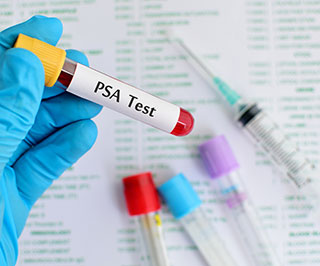 Image credit: nandyphotos/Thinkstockphotos.com
Image credit: nandyphotos/Thinkstockphotos.com
A change in health policy can have a dramatic effect on human behavior. Two studies in the Journal of the American Medical Association (JAMA) found that overall rates of prostate cancer screening and incidence dropped significantly after a national task force made multiple recommendations to cut back on universal screening for this disease.
In 2008, the U.S. Preventive Services Task Force (USPSTF) recommended against prostate-specific antigen (PSA) screening in men age 75 or older. Although incidence rates had declined in this age group since this recommendation was made, the impact of a 2012 USPSTF policy recommending against PSA screening for all men had yet to be determined.
Researchers in one of the JAMA studies wanted to find out what kind of collective impact both recommendations had on incidence and screening rates in older men. To do this, they analyzed data from 18 population-based Surveillance, Epidemiology, and End Results (SEER) registries to determine incidence in approximately 100,000 men age 50 or older who were newly diagnosed with prostate cancer, from the period of 2005 to 2012.
In addition, they assessed screening rates for men in this age group who had responded to the 2005, 2008, 2010 and 2013 National Health Interview Survey (NHIS), and who didn’t have a history of prostate cancer.
Overall, the researchers found notable drops in both incidence of and screening for prostate cancer during these time periods. As an example, in 2005, incidence per 100,000 in men 50 years or older was 535, prior to the implementation of the USPSTF guidelines. Rates began declining after 2008, however, with the biggest drop occurring between 2011 (498) and 2012 (416). Overall, “the number of men 50 years and older diagnosed with prostate cancer nationwide declined by 33,519, from 213,562 men in 2011 to 180,043 men in 2012,” according to the study results.
Screening rates among men age 50 or older had also declined since the implementation of the guidelines, dropping from 37% in 2005 to 31% in 2013. Although there had been an uptick in screening from 2005 to 2008, it fell by 18% from 2010 to 2013. “Similar screening patterns were found in age subgroups 50 to 74 years and 75 years and older,” according to the study’s authors.
The decline in early-stage prostate cancer in men aged 50 or older can be attributed to the fact that fewer men were getting screened as a result of the 2012 guidelines, the study’s lead author, Ahmedin Jemal, DVM, PhD, told CLN Stat. Jemal is vice president of the Surveillance and Health Services Research Program at the American Cancer Society (ACS).
“It’s also true that we are missing the opportunity to detect high-risk prostate cancers at early stages to avert deaths from prostate cancer in the future. On the other hand, however, we are also avoiding detection of indolent prostate cancer cases that need not be detected and treated, which is a major limitation of PSA testing,” Jemal said.
Another of the study’s authors, Otis W. Brawley, MD, FACP, ACS’s chief medical officer, observed that at least a dozen organizations, from ACS to the American Urological Association to the European Urology Association to the USPSTF “have looked at the scientific evidence and said there is legitimate question as to whether early detection saves lives. All agree that the harms associated with early detection and treatment are better proven than are the benefits.”
The other study in JAMA, which also relied on NHIS data, found that the biggest decreases in the incidence of cancer and screening rates following implementation of the USPSTF guidelines, took place among younger men.
Basing their results on more than 20,000 men aged 50 or older, the researchers found that “the prevalence of self-reported PSA testing was 35% in 2000 and 2005, was 36% in 2010, and declined to 31% in 2013,” David F. Penson, MD, MPH, wrote in a related editorial in JAMA. However, the most significant declines in screening took place among men ages 50 to 54, dropping from 23% in 2010 to 18% in 2013. Comparatively, screening frequency for those 75 years of age or older hasn’t changed much since 2008, indicating that elderly men seem to be ignoring the original recommendation to abstain from PSA screening.
“These findings using nationally representative data suggest that younger men may be altering health care behavior at a higher rate than older men following the new USPSTF recommendations, changes in clinician PSA screening practices have occurred in response to the policy change, or both,” the study’s authors suggested in the JAMA article, which was published as a research letter.
Physicians over the past 20 years may have been overzealous in screening for and treating prostate cancer, but these recent study results suggest “the pendulum may be swinging back the other way,” Penson wrote in his editorial. In his view, “it is time to accept that prostate cancer screening is not an ‘all-or-none’ proposition and to accelerate development of personalized screening strategies that are tailored to a man’s individual risk and preferences.”